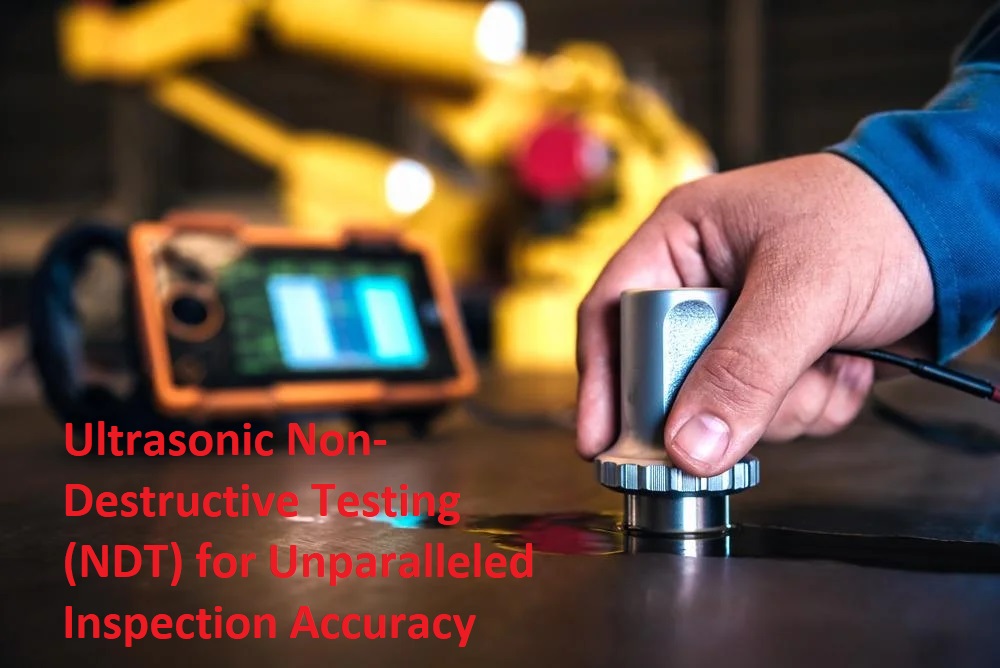Introduction to Ultrasonic Non-Destructive Testing (NDT)
Welcome to MechDNA’s comprehensive guide on Ultrasonic Non-Destructive Testing (NDT). In this article, we will delve into the world of ultrasonic testing, a powerful method used to characterize the thickness and internal structure of various materials with the aid of high-frequency sound waves. Ultrasonic NDT, also known as UT, has become a cornerstone in industrial and biomedical applications, enabling us to detect flaws and ensure the structural integrity of critical components.
How Ultrasonic Testing Works
At MechDNA, we pride ourselves on our in-depth knowledge of ultrasonic testing principles. When conducting an ultrasonic test, a specialized ultrasound transducer is employed, connected to a diagnostic machine. This transducer emits high-frequency sound waves into the test material, which then travel through the medium until they encounter a boundary with another material, causing them to reflect to the source.
By analyzing these reflections, we can obtain crucial information about the test piece. We can measure its thickness, and identify cracks, voids, disbonds, inclusions, and other internal flaws that may compromise its integrity. Ultrasonic testing is notably versatile, making it suitable for metals, plastics, composites, ceramics, and even in the biomedical field for diagnostic imaging and medical research.
Advantages of Ultrasonic Testing
At MechDNA, we recognize the immense benefits of ultrasonic testing. One of its most significant advantages lies in its non-destructive nature. Unlike other testing methods that may require cutting or exposing the material to damaging chemicals, ultrasonic testing allows us to inspect components without causing any harm.
Additionally, ultrasonic testing is highly efficient, requiring access to only one side of the test piece, which makes it more convenient than mechanical thickness tools. Moreover, it poses no health hazards like radiography, making it a safer choice for both the operator and the environment. When performed correctly, ultrasonic testing yields highly repeatable and reliable results, ensuring accurate inspections every time.
Potential Limitations of Ultrasonic Testing
MechDNA believes in transparency, and that includes acknowledging the potential limitations of any testing method. Ultrasonic flaw detection requires a trained operator who possesses the expertise to set up tests with reference standards and interpret results accurately. Complex geometries may present challenges during inspection, and the wide range of thickness measurements or acoustically diverse materials may necessitate multiple setups.
Furthermore, ultrasonic thickness gauges, though highly accurate, can be more expensive than mechanical measurement devices. Despite these limitations, MechDNA skilled professionals are well-equipped to handle various testing scenarios with precision and proficiency.
Ultrasonic Testing of Welds
One area where ultrasonic testing truly shines is in weld inspections. MechDNA excels in this domain, as our highly-trained operators can determine the exact position of a discontinuity in a weld. This advanced testing method applies to both ferrous and non-ferrous materials, making it versatile for a wide range of applications. Ultrasonic testing is particularly suited for thicker sections accessible from one side only, and it excels in detecting finer lines and plainer defects that may be challenging to identify using radiographic testing.
International Standards for Ultrasonic Testing
At MechDNA, we uphold the highest standards in ultrasonic testing to ensure the utmost accuracy and reliability. We adhere to renowned international organizations’ guidelines, including the International Organization for Standardization (ISO) and the European Committee for Standardization (CEN). These standards, such as ISO 7963, ISO/DIS 11666, ISO/DIS 17640, EN 583, EN 1330-4, and many others, are crucial in establishing uniformity and excellence in ultrasonic testing practices.
Frequently Asked Questions (FAQ) on Ultrasonic Testing
To further enlighten our readers, we’ve compiled a list of frequently asked questions about ultrasonic testing:
- What is an Ultrasonic Transducer?
- An ultrasonic transducer converts electrical energy into mechanical vibrations (sound waves) and vice versa. It is a fundamental component in ultrasonic testing, allowing us to generate and receive ultrasonic signals during inspections.
- What is an Ultrasonic Thickness Gage?
- An ultrasonic thickness gauge is a precise instrument used to generate sound pulses in a test piece and accurately measure the time interval until echoes are received. It helps us calculate the thickness of the material based on sound velocity and time.
- How Accurate is Ultrasonic Thickness Gaging?
- Under optimum conditions, commercial ultrasonic gages can achieve accuracies as high as +/- 0.001 mm, with better accuracy possible in most common engineering materials. Several factors, such as sound velocity uniformity, scattering, and absorption, can influence accuracy.
- Who Uses Ultrasonic Gages?
- Ultrasonic gages find application in measuring remaining wall thickness in corroded pipes and tanks, among other uses. They are widely utilized in industries like manufacturing, aerospace, medical, and more.
- What is an Ultrasonic Flaw Detector?
- An ultrasonic flaw detector is an instrument used to generate and process ultrasonic signals, creating a waveform display. Trained operators analyze the display to identify hidden flaws like cracks and voids in test pieces.
- What Types of Flaws Can You Find with Ultrasonic Flaw Detectors?
- Ultrasonic flaw detectors can locate a wide range of flaws that affect structural integrity, including cracks, voids, disbands, inclusions, and more.
- Who Uses Ultrasonic Flaw Detectors?
- Ultrasonic flaw detectors are employed in critical safety-related and quality-related applications in various industries, including aerospace, automotive, construction, manufacturing, and others.
Conclusion
In conclusion, ultrasonic non-destructive testing is an indispensable tool in the world of engineering, allowing us to inspect and verify the structural integrity of vital components without causing any damage. At MechDNA, we pride ourselves on our expertise in ultrasonic testing, adhering to international standards and delivering precise, reliable results for our clients.
If you require ultrasonic testing services or have any inquiries about this advanced testing method, don’t hesitate to contact MechDNA. Our team of skilled professionals is ready to assist you in ensuring the safety and quality of your engineering projects.
#MechDNAUltrasonic Non-Destructive Testing (NDT) for Unparalleled Inspection Accuracy
